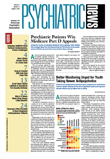Using strains of mice inbred to display either low or high anxiety-like behavior, researchers in California are looking for new ways to think about therapeutic strategies for anxiety disorders, reported Carrolee Barlow, M.D., Ph.D., of Brain Cells Inc. in San Diego, Calif., at a meeting of the American Society for Genetic Therapy in Baltimore.
Panic disorder, obsessive-compulsive disorder, posttraumatic stress disorder, social phobia, and other anxiety disorders are familiar diagnoses in DSM-IV and in the caseloads of most psychiatrists. For the moment, SSRIS, MAOIs, benzodiazepines, and beta-blockers are used to control symptoms as neuroscientists search for brain regions and genetic switches to explain and treat these conditions.
While the presence of true anxiety cannot be confirmed in mice, scientists have found valid analogues.
“In animals, you have to rely on anxiety-like behavior because you don't know if they have real anxiety,” explained Barlow, who collaborates with scientists at the Salk Institute for Biological Studies and others.
Mouse anxiety reveals itself in several measures of the animals' behavior. For instance, the open-field test measures the time mice spend in the middle of the test area compared with hugging the wall around the field. More-anxious mice spend more time near the edge, presumably a more comforting, less-exposed location, than do less-anxious mice, who spend more time in the open.
Barlow and her colleagues used microarray technology to assess the expression levels of about 10,000 possible genes in seven brain areas. Analysis of the results found a correlation between 17 candidate genes and anxiety-related phenotypes across all the mouse strains tested.
“These genes were not just differentially expressed, but were differentially expressed in a pattern matching anxiety behavior,” said Barlow. A statistically significant pattern also distinguished the most and least anxious strains of mice.
Five of the 17 candidate genes expressed enzymes. Of those, glyoxalase 1 (Glo1) and glutathione reductase 1 (Gsr) had activity assays available and correlated with anxiety-like behavior. They also matched the pattern found in the microarrays and in subsequent reverse transcriptase quantitative polymerase chain reaction analysis. The highest activities of these two enzymes occurred in the most anxious strain and the lowest in the least anxious. The next step was to see whether expression of these two enzymes might cause anxiety.
Regulation of anxiety and fear occurs in the amygdala, periaqueductal gray, pituitary gland, hypothalamus, hippocampus, cingulate cortex, and the bed nucleus of the stria terminalis. The researchers chose the cingulate cortex as their initial target.
Barlow and her colleagues attached the two relevant genes, Glo1 or Gsr, or a control protein to lentiviruses and injected them into the cingulate cortex of both anxious and nonanxious strains of mice, and in F1 crosses between the two strains. Lentiviral vectors can enter central nervous systems cells and don't cause cytotoxicity. The gene-bearing viral vectors caused overexpression of the Glo1 or Gsr genes when they infect the brain. Both genes increased anxiety behavior in both groups of mice.
The researchers next sought to decrease anxiety-like behavior by using a small interfering RNA (siRNA), which inhibits Glo1 expression. Both an anxious mouse strain and an intermediate strain spent significantly more time in the middle of the test chamber than did control mice when an siRNA against Glo1 was injected into the cingulate cortex.
The two genes are part of a pathway that regulates oxidative stress, said Barlow, suggesting that misregulation of oxidative stress may lead to anxiety. Gsr regulates glutathione, a major antioxidant in the brain, and Glo1 uses glutathione as a cofactor to detoxify cytotoxic methylglyoxal. Other studies have suggested that oxidative stress may be involved in other neuropsychiatric disorders.
Barlow said it is too soon to argue for the effect of a single gene on a complex behavior like anxiety, but “it's better to start with a very selective pharmacological approach, rather than a systemic one, to better tease out the effects of each gene.”
These newly identified genes mark another step in understanding how mouse (and eventually human) brains regulate normal and pathological anxiety, she said.
More information on this topic appeared in an article by the same researchers in Nature in 2005. It is posted at<www.nature.com/nature/journal/v438/n7068/abs/nature04250.html;jsessionid=470C376688A618E7861367CEF4D4EEC3>.▪
